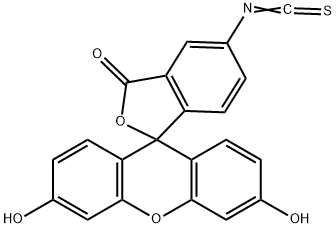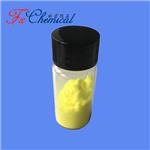Description
Fluorescein 5-isothiocyanate (5-FITC) is an isomer of fluorescein isothiocyanate (FITC), which is commonly used as a mixture of the 5- and 6-isothiocyanate isomers. It reacts with amine and thiol groups to form conjugates with proteins, lipids, and other molecules for detection by a variety of fluorescent-based applications. 5-FITC displays excitation/emission maxima of 494/519 nm, respectively.
Chemical Properties
Fluorescein isothiocyanate(3326-32-7) is an orange-yellow crystal that is hygroscopic. It can be combined with various antibody proteins, and the combined antibody does not lose its specificity for binding to a certain antigen, and still has strong green fluorescence in alkaline solution, precipitates out after adding acid, and the fluorescence disappears. It is slightly soluble in acetone and ether and petroleum ether.
Uses
Fluorescein isothiocyanate isomer I has been used for the staining of conidia. It is a kind of fluorescent marker for biochemical applications. Reacts under mild conditions with primary amines and it is also used in modification of actin at lys-61, labelling of FAB and the modification of thiol groups.
Application
Fluorescein isothiocyanate is used as fluorescent labeling reagent for proteins and for rapid identification of pathogens in fluorescent antibody technique. It is also used as a reagent for microsequencing of proteins and peptides (HPLC). On celite it is used for the labeling of fibrinogen.
Definition
ChEBI: Fluorescein 5-isothiocyanate is the 5-isomer of fluorescein isothiocyanate. Acts as a fluorescent probe capable of being conjugated to tissue and proteins; used as a label in fluorescent antibody staining procedures as well as protein- and amino acid-binding techniques.
General Description
Fluorescein isothiocyanate (FITC) is yellow-orange in color with an absorption maximum at 495nm. Upon excitation, it emits a yellow-green color with an emission maximum at 525nm.
It is widely used to attach a fluorescent label to proteins via the amine group. The isothiocyanate group reacts with amino terminal and primary amines in proteins. It has been used for the labeling of proteins including antibodies and lectins.
Fluorescein isothiocyanate isomer I has been proposed as a contact sensitizer.
Purification Methods
It is made from the pure 5-amino isomer. Purify it by dissolving it in boiling Me2CO, filtering and adding pet ether (b 60-70o) until it becomes turbid. If an oil separates, then decant it and add more pet ether to the supernatant and cool. Orange-yellow crystals separate, collect and dry them in vacuo. It should give one spot on TLC (silica gel) in EtOAc/pyridine/AcOH (50:1:1) and in Me2NCHO/CHCl3/28% NH4OH (10:5:4). IR (Me2SO): 2110 (NCS) and 1760 (C=O) cm-1. The max 1HNMR spectra in Me2CO-d6 of the 5-and 6-isomers are distinctly different for the protons in the *benzene ring; the UV in phosphate buffer pH 8.0 shows a at ~490nm. [Sinsheimer et al. Anal Biochem 57 2271974, McKinney et al. Anal Biochem 7 74 1964, Beilstein 19 III/IV 4337.]




